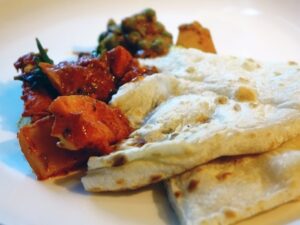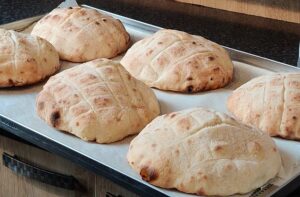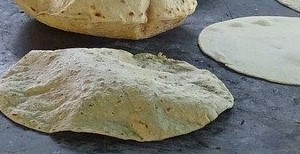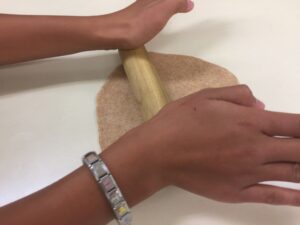 Flatbread is a type of bread that is just that, flat! Some flatbreads are unleavened, meaning they are not made with an ingredient, such as yeast or baking soda, to help them rise. Others are leavened just slightly, to form a sort of flattened pillow. Many flatbreads are a round-ish shape. Most flatbreads are made with flour, salt, water, milk, yogurt, or some other liquid; however, ingredients vary from culture to culture.
Flatbread is a type of bread that is just that, flat! Some flatbreads are unleavened, meaning they are not made with an ingredient, such as yeast or baking soda, to help them rise. Others are leavened just slightly, to form a sort of flattened pillow. Many flatbreads are a round-ish shape. Most flatbreads are made with flour, salt, water, milk, yogurt, or some other liquid; however, ingredients vary from culture to culture.
Types of Flatbread
There are too many types of flatbreads to list, but these are just a few.
 Pita, often made with wheat flour, water, olive oil, yeast, and salt – common in some Mediterranean regions, such as Greece and Turkey.
Pita, often made with wheat flour, water, olive oil, yeast, and salt – common in some Mediterranean regions, such as Greece and Turkey.- Naan, typically made with wheat flour, water, ghee (clarified butter), yeast, and salt. These are popular in some areas in the Middle East and Asia, such as Iran and India.
- Yufka, very flat and large unleavened flatbread made with flour, water, and salt – made in Turkey.
- Tortilla, unleavened flatbread made traditionally from corn flour (masa) and now wheat flour as well, plus water, salt and sometimes lard and milk. Originating in Mexico and Central America, tortillas are a staple in many households.
- Injera, sour fermented flatbread made with teff flour that has a flimsy, spongy texture. This a staple food in Ethiopia.
Flatbreads, like injera, can be used as a utensil to scoop up other foods when eating. Tortillas, can be topped and folded in half and eaten like a taco. Pitas contain a pocket, so when cut in half and can be stuffed with meats, vegetables and eaten like a sandwich. Or they may be simply torn into pieces and dipped in hummus or used to soak up sauces.
Making Flatbread
 Try your hand at a few different flatbreads and incorporate them into different meals. This is as a fun way to explore the tastes of different cultures. Most flatbreads can be made in large batches and frozen for thawing and eating later. Because there are no preservatives in homemade flatbread, it is best to eat freshly made flatbread within 2-4 days, and then freeze the rest. After thawing, you may prefer to toast it slightly in the toaster or toaster oven to warm it up a bit.
Try your hand at a few different flatbreads and incorporate them into different meals. This is as a fun way to explore the tastes of different cultures. Most flatbreads can be made in large batches and frozen for thawing and eating later. Because there are no preservatives in homemade flatbread, it is best to eat freshly made flatbread within 2-4 days, and then freeze the rest. After thawing, you may prefer to toast it slightly in the toaster or toaster oven to warm it up a bit.
Making Flatbread with Children
 While it may be messy, getting children in the kitchen to help with cooking projects is so much fun! It also provides children with an opportunity to use their fine motor skills, math skills, and senses. Cooking and baking can be therapeutic for many children and adults alike. It facilitates quality family time, with the reward of a delicious treat in the end. Make flatbread with your children! It is an easy baking project that requires few ingredients and a fairly simple process. Children may love to get their hands in the dough but do remind them to wash their hands first.
While it may be messy, getting children in the kitchen to help with cooking projects is so much fun! It also provides children with an opportunity to use their fine motor skills, math skills, and senses. Cooking and baking can be therapeutic for many children and adults alike. It facilitates quality family time, with the reward of a delicious treat in the end. Make flatbread with your children! It is an easy baking project that requires few ingredients and a fairly simple process. Children may love to get their hands in the dough but do remind them to wash their hands first.


This is a great activity to do anytime, but especially during hot weather, when baking bread heats up the kitchen.